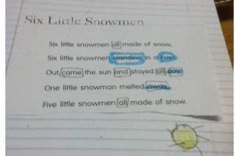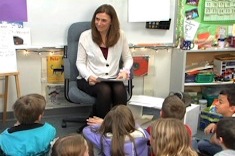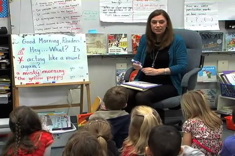“Hey, look at the next page! It’s about a tiger!”
Robert, whom many referred to as all boy or by some initialism that gets tossed around to explain student listlessness, was flipping through my teacher-curated poetry book. From my side of the carpet, it wasn’t clear whether he was making the book into a musical instrument or fanning his thumb, but Robert had obviously landed on a page that had caught his attention.
I hate to admit it, but often when students have a pattern of behavior, teachers begin to overlook the small moments of genius that percolate through the eraser rubbing, carpet pulling, or pen deconstructing of a student trying to self-regulate. And so I glossed over Robert’s zeal for a poem not yet discussed in class.
Today’s poem had been planned. It used rhyme scheme and repetition and was ready to be dissected and turned open. The learning target was in place, and the academic vocabulary had been explored. It wasn’t in the plans to just jump willy-nilly into another poem. The class wasn’t ready for it yet. Without rhyme and repetition, how could they possibly make the leap to imagery?
But Robert was ready.
“I don’t really get it, but it’s about fire and burning and stuff!” Students around Robert leaned in, and others began flipping pages. Others began turning and flipping and searching for their own tiger. I paused. I looked around. What was happening? What should I do?
Robert had started his own fire. Little did I know that day that Robert would change the way I teach poetry.
It Begins with You
To teach poetry, you must love poetry. Loving poetry requires only two ingredients: a brain and a heart. We all have those, don’t we? So then why do so many of us skip the poetry and head to the novels? What scares us? In today’s culture there is little difference between the 17-syllable restriction of a haiku and the 140-character limit of a tweet. In today’s world of sound bites and quick reads, poetry should be having a revival.
Are your defenses up? Have you been burned by poetry in the past? Did the blank spaces on the page leave you breathless, winded from your journey along the typed trails and spotted plains of e.e. cummings or the laborious allusions of T. S. Elliot? Is that the message you’d send your students?
Find poems you love. If you can’t, ask for help from colleagues who love poems. Once you find them, bring them into the classroom and let them drip from the page, hang in the air, and flood the floor. Read and reread poetry to your students, and reveal to them the hidden staircases and trapdoors. If you can’t find your way, let them follow you on your quest. Sometimes the ingenuity of a child can unlock the most mature machinations of poets.
Letting Go
My favorite movie and most likely the first inspiration I had to teach was Dead Poets Society. In one of the most poignant scenes, Robin Williams masterfully dupes the young scholars into reading the first page of a text that takes a cold, analytic approach to poetry. Finally he flips the lesson on its head, instructing the students to rip the introduction out of their books, shredding its ideology and ushering in a love of poetry rooted in its magic and soul.
Before attaching a standard or a target, we must “suck the marrow” of poetry to unlock its power in each student. Read it, savor it, don’t judge it, and don’t judge students’ reactions. Shel Silverstein not only wrote poetry that could make students laugh but also played with language, twisted forms, and created character. Though I was tempted to keep multiple copies of his books in my room, I instead chose the right moment with the right student. And as that reluctant reader began to snicker audibly, turn pages, and share the hilarity in those verses, I would stand back and watch Shel’s genius spread like wildfire across the carpet, tables, and chairs of unsuspecting students. I didn’t do it, Shel did. I just gave him the reins and said go.
Many teachers may have stopped Robert and told him to stay on task or, even worse, to “clip down.” My indecisive moment let me observe the phenomenon that happens when one student’s discovery is blurted out.
In that pause I let go. I let Robert lead the charge in reading a poem about a tiger. As the class shared and discussed the poem, I observed, took notes, and answered questions with questions. The students were ready.
Going back to the image of Robin Willams as Professor Keating, I remembered the true genius of his teaching. Sure, he read poetry in character, stood on a desk, and spoke with ignited enjoyment, but the true genius came when he allowed his students to discover poetry for themselves.
Now I teach poetry that I love and commission my students to find poems that inspire them, make them laugh or cry, or move them though they may not know why. Not a poem with rhythm, a certain structure, or key imagery. Instead I ask them to collect and share with others the poems they love. I put out all my poetry anthologies and collections, play Shel reading his own work (“Peanut-Butter Sandwich” is a must!) and just let poetry do its thing.
During this time, there will be students who tread cautiously, taking toe dips into poetry that’s safe. They’ll stay with poems that are silly or short or ones you’ve already shared. It’s scary to let poetry in, remember. These are moments of great opportunity to unlock and inspire. These are the students who will remember 40 years later the moment when they finally found the verse that mattered.









